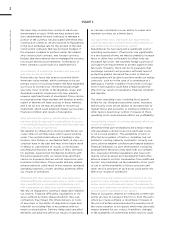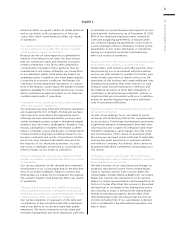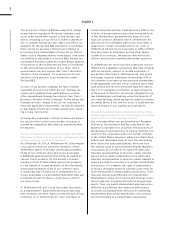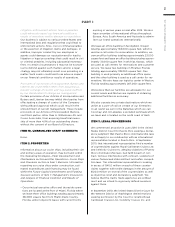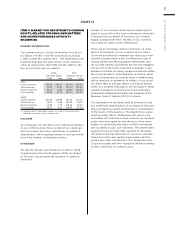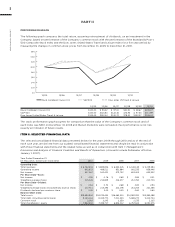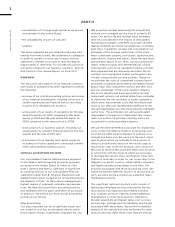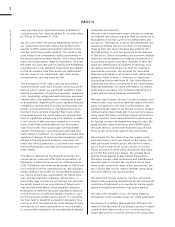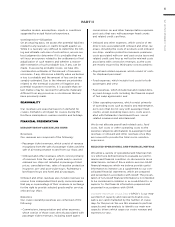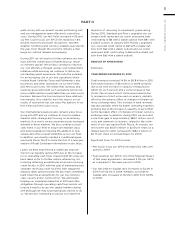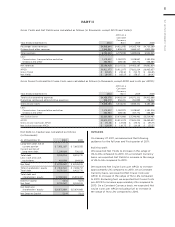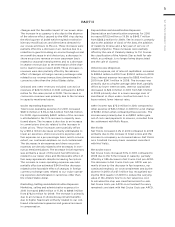Royal Caribbean Cruise Lines 2010 Annual Report Download - page 42
Download and view the complete annual report
Please find page 42 of the 2010 Royal Caribbean Cruise Lines annual report below. You can navigate through the pages in the report by either clicking on the pages listed below, or by using the keyword search tool below to find specific information within the annual report.
PART II
ROYAL CARIBBEAN CRUISES LTD. 39
related to planned major maintenance activities nec-
essary to maintain Class. The costs deferred are not
otherwise routinely periodically performed to maintain
a vessel’s designed and intended operating capability.
Repairs and maintenance activities are charged to
expense as incurred.
We use judgment when estimating the period between
drydocks, which can result in adjustments to the esti-
mated amortization of drydock costs. If the vessel is
disposed of before the next drydock, the remaining
balance in deferred drydock is written-off to the gain
or loss upon disposal of vessel in the period in which
the sale takes place. We also use judgment when
identifying costs incurred during a drydock which
are necessary to maintain the vessel’s Class certifi-
cation as compared to those costs attributable to
repairs and maintenance which are expensed as
incurred. (See Note 2. Summary of Significant
Accounting Policies to our consolidated financial
statements under Item 8. Financial Statements and
Supple ment ary Data).
We believe we have made reasonable estimates for
ship accounting purposes. However, should certain
factors or circumstances cause us to revise our esti-
mates of ship service lives or projected residual values,
depreciation expense could be materially higher or
lower. If circumstances cause us to change our assump-
tions in making determinations as to whether ship
improvements should be capitalized, the amounts we
expense each year as repairs and maintenance costs
could increase, partially offset by a decrease in depre-
ciation expense. If we had reduced our estimated
average 30-year ship service life by one year, depre-
ciation expense for 2010 would have increased by
approximately $46.0 million. If our ships were esti-
mated to have no residual value, depreciation expense
for 2010 would have increased by approximately
$151.0 million.
Valuation of Long-Lived Assets, Goodwill and
Indefinite-Lived Intangible Assets
We review our ships and other long-lived assets for
impairment whenever events or changes in circum-
stances indicate that the carrying amount of these
assets may not be fully recoverable. The assessment
of possible impairment is based on our ability to
recover the carrying value of these assets based on
our estimate of their undiscounted future cash flows.
If estimated future cash flows are less than the carry-
ing value of an asset, an impairment charge is recog-
nized for the difference between the asset’s estimated
fair value and its carrying value.
We determine fair value based on quoted market prices
in active markets, if available. If active markets are not
available we base fair value on independent apprais-
als, sales price negotiations and projected future cash
flows discounted at a rate determined by management
to be commensurate with the business risk. Quoted
market prices are often not available for individual
reporting units and for indefinite-life intangible assets.
Accordingly, we base the fair value of a reporting unit
and an indefinite-life intangible asset on an expected
present value technique.
We review goodwill, trademarks and tradenames,
which are our most significant indefinite-lived intangi-
ble assets, for impairment whenever events or circum-
stances indicate but at least annually. The impairment
review for goodwill consists of a two- step process
of first determining the fair value of the reporting unit
and comparing it to the carrying value of the net assets
allocated to the reporting unit. If the fair value of the
reporting unit exceeds the carrying value, no further
analysis or write-down of goodwill is required. If the
fair value of the reporting unit is less than the carry-
ing value of its net assets, the implied fair value of the
reporting unit is allocated to all its underlying assets
and liabilities, including both recognized and unrec-
ognized tangible and intangible assets, based on their
fair value. If necessary, goodwill is then written down
to its implied fair value. The impairment review for
indefinite-life intangible assets consists of a compari-
son of the fair value of the asset with its carrying
amount. If the carrying amount exceeds its fair value,
an impairment loss is recognized in an amount equal
to that excess. If the fair value exceeds its carrying
amount, the indefinite-life intangible asset is not con-
sidered impaired.
We performed our annual impairment review for
goodwill during the fourth quarter of 2010. We deter-
mined the fair value of our two reporting units which
include goodwill, Royal Caribbean International and
Pullmantur, using a probability-weighted discounted
cash flow model. The principal assumptions used in
the discounted cash flow model are projected operat-
ing results, weighted-average cost of capital, and ter-
minal value. Cash flows were calculated using our 2011
projected operating results as a base. To that base
we added future years’ cash flows assuming multiple
revenue and expense scenarios that reflect the impact
on each reporting unit of different global economic
environments beyond 2011. We assigned a probability
to each revenue and expense scenario.
We discounted the projected cash flows using rates
specific to each reporting unit based on their respec-
tive weighted-average cost of capital. Based on the
probability-weighted discounted cash flows of each
reporting unit we determined the fair values of Royal
Caribbean International and Pullmantur exceeded
their carrying values. Therefore, we did not proceed
to step two of the impairment analysis and we do not
consider goodwill to be impaired. Royal Caribbean
International’s reporting unit’s fair value exceeded its



